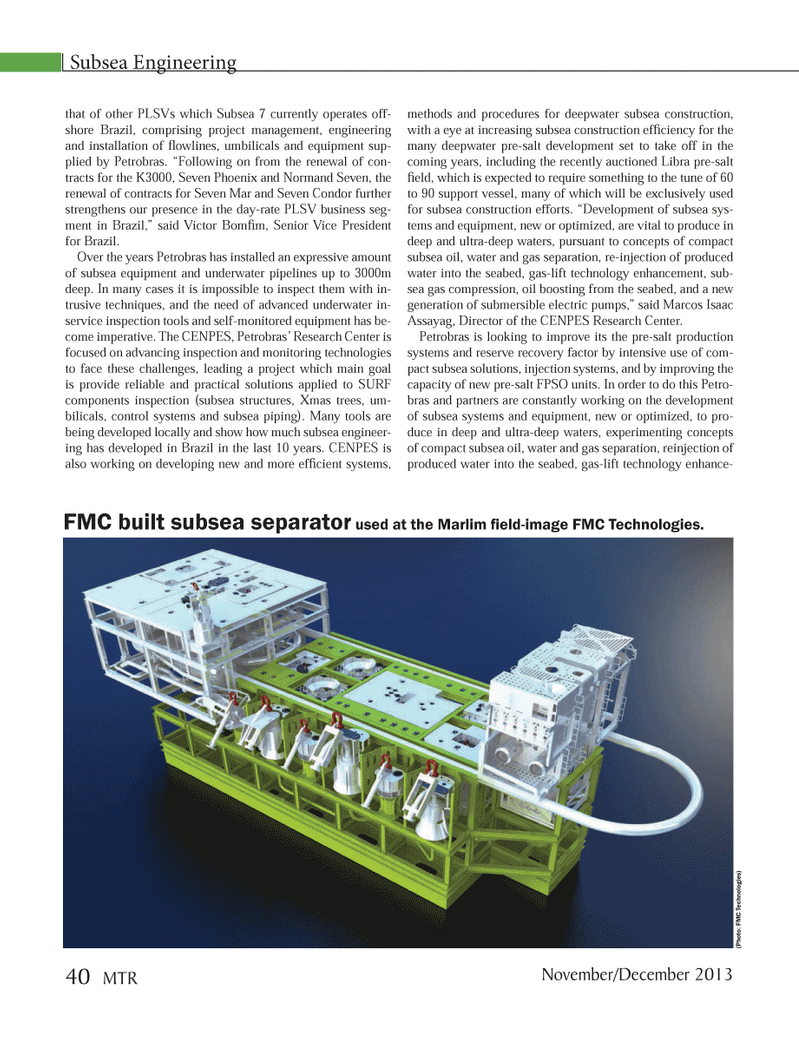
Page 40: of Marine Technology Magazine (November 2013)
Fresh Water Monitoring & Sensors
Read this page in Pdf, Flash or Html5 edition of November 2013 Marine Technology Magazine
that of other PLSVs which Subsea 7 currently operates off- shore Brazil, comprising project management, engineering and installation of ß owlines, umbilicals and equipment sup- plied by Petrobras. ÒFollowing on from the renewal of con- tracts for the K3000, Seven Phoenix and Normand Seven, the renewal of contracts for Seven Mar and Seven Condor further strengthens our presence in the day-rate PLSV business seg- ment in Brazil,Ó said Victor BomÞ m, Senior Vice President for Brazil.Over the years Petrobras has installed an expressive amount of subsea equipment and underwater pipelines up to 3000m deep. In many cases it is impossible to inspect them with in- trusive techniques, and the need of advanced underwater in- service inspection tools and self-monitored equipment has be-come imperative. The CENPES, PetrobrasÕ Research Center is focused on advancing inspection and monitoring technologies to face these challenges, leading a project which main goal is provide reliable and practical solutions applied to SURF components inspection (subsea structures, Xmas trees, um-bilicals, control systems and subsea piping). Many tools are being developed locally and show how much subsea engineer- ing has developed in Brazil in the last 10 years. CENPES is also working on developing new and more efÞ cient systems, methods and procedures for deepwater subsea construction, with a eye at increasing subsea construction efÞ ciency for the many deepwater pre-salt development set to take off in the coming years, including the recently auctioned Libra pre-salt Þ eld, which is expected to require something to the tune of 60 to 90 support vessel, many of which will be exclusively used for subsea construction efforts. ÒDevelopment of subsea sys- tems and equipment, new or optimized, are vital to produce in deep and ultra-deep waters, pursuant to concepts of compact subsea oil, water and gas separation, re-injection of produced water into the seabed, gas-lift technology enhancement, sub- sea gas compression, oil boosting from the seabed, and a new generation of submersible electric pumps,Ó said Marcos Isaac Assayag, Director of the CENPES Research Center. Petrobras is looking to improve its the pre-salt production systems and reserve recovery factor by intensive use of com- pact subsea solutions, injection systems, and by improving the capacity of new pre-salt FPSO units. In order to do this Petro- bras and partners are constantly working on the development of subsea systems and equipment, new or optimized, to pro- duce in deep and ultra-deep waters, experimenting concepts of compact subsea oil, water and gas separation, reinjection of produced water into the seabed, gas-lift technology enhance- Subsea Engineering FMC built subsea separator used at the Marlim Þ eld-image FMC Technologies. (Photo: FMC Technologies) November/December 201340 MTRMTR #9 (34-49).indd 40MTR #9 (34-49).indd 4012/12/2013 12:14:02 PM12/12/2013 12:14:02 PM

 39
39

 41
41
